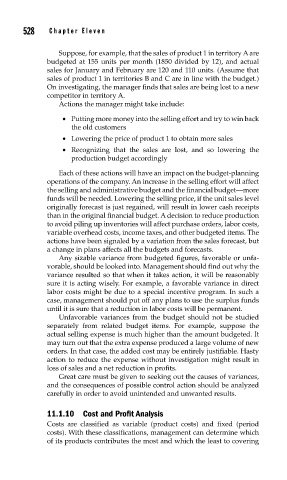Page 575 - Sensors and Control Systems in Manufacturing
P. 575
528
Ele v e n
Cha p te r
Suppose, for example, that the sales of product 1 in territory A are
budgeted at 155 units per month (1850 divided by 12), and actual
sales for January and February are 120 and 110 units. (Assume that
sales of product 1 in territories B and C are in line with the budget.)
On investigating, the manager finds that sales are being lost to a new
competitor in territory A.
Actions the manager might take include:
• Putting more money into the selling effort and try to win back
the old customers
• Lowering the price of product 1 to obtain more sales
• Recognizing that the sales are lost, and so lowering the
production budget accordingly
Each of these actions will have an impact on the budget-planning
operations of the company. An increase in the selling effort will affect
the selling and administrative budget and the financial budget—more
funds will be needed. Lowering the selling price, if the unit sales level
originally forecast is just regained, will result in lower cash receipts
than in the original financial budget. A decision to reduce production
to avoid piling up inventories will affect purchase orders, labor costs,
variable overhead costs, income taxes, and other budgeted items. The
actions have been signaled by a variation from the sales forecast, but
a change in plans affects all the budgets and forecasts.
Any sizable variance from budgeted figures, favorable or unfa-
vorable, should be looked into. Management should find out why the
variance resulted so that when it takes action, it will be reasonably
sure it is acting wisely. For example, a favorable variance in direct
labor costs might be due to a special incentive program. In such a
case, management should put off any plans to use the surplus funds
until it is sure that a reduction in labor costs will be permanent.
Unfavorable variances from the budget should not be studied
separately from related budget items. For example, suppose the
actual selling expense is much higher than the amount budgeted. It
may turn out that the extra expense produced a large volume of new
orders. In that case, the added cost may be entirely justifiable. Hasty
action to reduce the expense without investigation might result in
loss of sales and a net reduction in profits.
Great care must be given to seeking out the causes of variances,
and the consequences of possible control action should be analyzed
carefully in order to avoid unintended and unwanted results.
11.1.10 Cost and Profit Analysis
Costs are classified as variable (product costs) and fixed (period
costs). With these classifications, management can determine which
of its products contributes the most and which the least to covering

